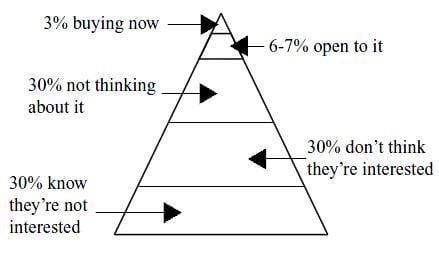The Buyer’s Pyramid
What makes a buyer ready to buy? How severe is a pain before the buyer will depart with funds to acquire your product or service? As I have said before: status quo should be on your list of competitors. Sometimes the alternative is more daunting than whatever system is in place at the moment, and the current situation is “good enough”.
So when you are organizing a promotional campaign, remember that you don’t know how many members of your audience are actively buying right now.
Thankfully, strategist Chet Holmes has done the math and summarized how much of any given audience is likely to be buying at any moment in time.
Chet Holmes’ Buyer’s Pyramid

3%. That is the group of people actively buying.
Assume your campaign targets 100 people. Three of them respond. What is your conversion rate? Even at 60%, that means two new sales. What is your margin, taking into account the time and resources spent on your campaign?
Maybe the sales are high value, and you make a profit. Imagine what that would be if you were speaking to the top 70% of that pyramid, rather than the top 3%.
Tell Them About Themselves
The 93% of that audience who is not buying right now may not be open to a sales pitch, but they probably are open to learning something new that will impact their business.
When crafting your message, don’t tell people about you. Tell them about themselves. Give them information they can use in their work: share research or news that will impact their business and ideas for avoiding future problems. Then, and only then, tie it back to your own offering. Now you are not just telling your audience that you exist and what you do, but also why it will make their lives and businesses better.
The fact that you sell pens means nothing to somebody who never writes, or who owns a pencil. The permanence of ink, importance of written messages for repetition and future retrieval, value of note taking on paper: these are all “new” reasons for people to invest in pens. Once you convince me of these needs – even if I was not thinking about buying a pen or was perfectly content with my pencil – I am seeing the value of owning a pen, and am considering spending money on one.
Next Step: Focus on the 60%
You know your top three percent are open to your message, and the next 6-7% are receptive to it (if you make the value immediately obvious).
Focus on the middle 60% of the buyer’s pyramid. What can you tell them that will resonate? How can you attract their attention first, and then communicate the value of a new solution. What education will help them see an upside to investing in a change now, rather than waiting for something in their current system to completely break down?
Craft a story for the 60%, and you will automatically be speaking to the 70% top of the pyramid. As for the bottom 30%: at the very least they may learn something new, which starts your relationship with a positive impression, one you can build on later when they have more reason to consider a purchase.